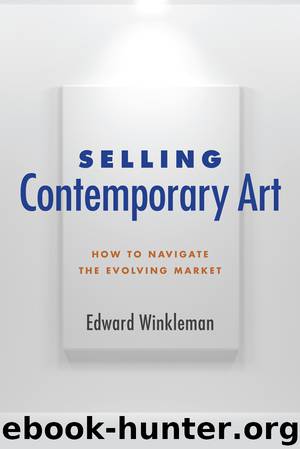Selling Contemporary Art by Edward Winkleman

Author:Edward Winkleman
Language: eng
Format: epub
Publisher: Allworth Press
Published: 2015-01-01T05:00:00+00:00
The Second Story
New York-based collector Glenn Fuhrman, who with his wife Amanda are also ranked among the world’s top 200 collectors, shared a story with me in an interview for this book as well. Working in finance, Glenn said he is frequently approached by colleagues in the industry who are interested in becoming involved in collecting contemporary art as he is well known to be. In three such cases he introduced inquiring colleagues to one of New York’s best art consultants and explained how it’s good to begin collecting with some expert advice on how one should go about it. Later on, that consultant told Glenn that those three introductions had each explained within a few minutes of their first meetings that they wanted to collect the kind of work that was likely to increase substantially in price over the next year. No amount of discussing the other rewards of collecting seemed to sway them from this position. The consultant also reported that she told the three referred colleagues that she was not the right consultant for them. Glenn tells this story not just as an example of how speculative goals are driving wealthy people toward collecting, but how formerly successful appeals to their interest in connoisseurship currently don’t seem to resonate like they used to, at least with these specific examples if not many others.
Whether the rate of flipping has reached a historic high or not, the impact of the perception that it has was already at work in changing things for mid-level dealers. Perhaps only anecdotally, sure, but still enough to consider what strategies can be used should you encounter a similar situation in your business. Below we will consider a couple of ways to respond to the perception that speculation is the best way to collect contemporary art now.
Strategies for Responding to Speculative Versus Connoisseurship-Based Collecting
I only have two strategies to discuss here, and whichever appeals to you the most more or less cancels out how effective the other one may be in your case. Personally, I would love to see more dealers work with the first strategy, even as I appreciate that it’s more difficult and less likely to succeed. My reason for preferring the first, though, is that the more galleries embrace the second strategy, the less room there will be in the commercial art system for the kind of work that is not easy to flip. As noted above, mid-level galleries only survive if they can balance out well-selling artists in their roster with those they are perhaps supporting for more personal and less business-minded reasons. There is no glory, or sense, in going out of business by standing on some sort of paradoxically anti-commercial principle. Then again, many of my favorite galleries manage to get that balance just right and over time are even able to nudge their collectors toward the less obvious choices. This is where dealers contribute to the cultural legacy of this generation, much more so than moving currently fashionable product around.
Download
This site does not store any files on its server. We only index and link to content provided by other sites. Please contact the content providers to delete copyright contents if any and email us, we'll remove relevant links or contents immediately.
Things Are What You Make of Them: Life Advice for Creatives by Adam J. Kurtz(1774)
The Monuments Men by Robert M. Edsel(1701)
The Freelance Manifesto: A Field Guide for the Modern Motion Designer by Joey Korenman(1520)
Find Your Artistic Voice by Lisa Congdon(1346)
The Business of Being an Artist by Daniel Grant(1301)
101 Gag Ideas: Companion to the One Minute Caricature by James van der Keyl(1279)
Boom by Michael Shnayerson(1251)
Your Art Will Save Your Life by Beth Pickens(1202)
Your Inner Critic Is a Big Jerk by Danielle Krysa(1196)
Breakfast at Sotheby's(1161)
The Lady in Gold by Anne-marie O'connor(1153)
Seven Days in the Art World by Sarah Thornton(1140)
Create Your Art Career by Rhonda Schaller(1138)
How to Survive and Prosper as an Artist by Caroll Michels(1113)
When Talent Isn't Enough: Business Basics for the Creatively Inclined by Kristen Fischer(1073)
33 Artists in 3 Acts by Sarah Thornton(1070)
Need you Now (Top Shelf Romance Book 2) by unknow(1037)
Art Held Hostage by John Anderson(1032)
Art of the Deal by Noah Horowitz(1030)
